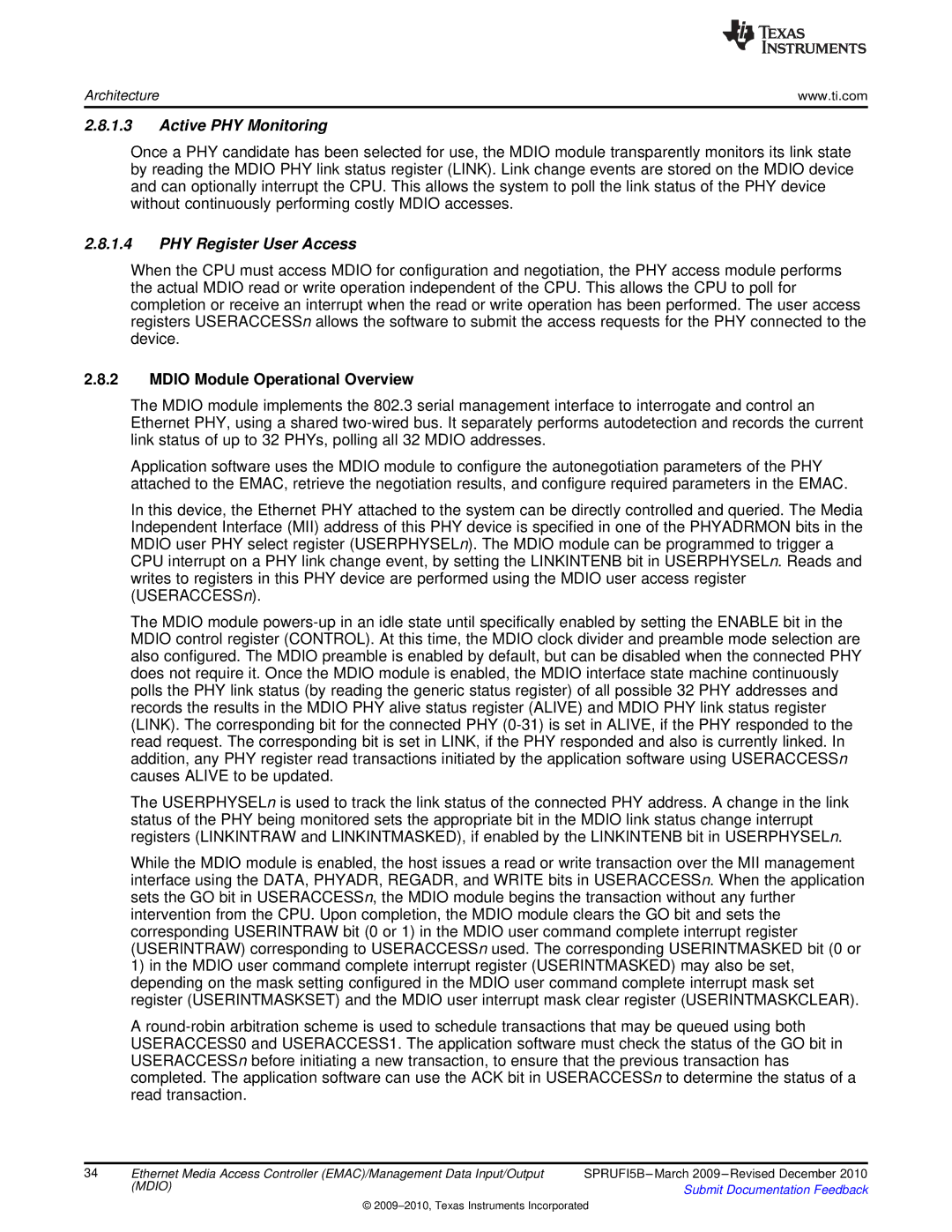
Architecture | www.ti.com |
2.8.1.3Active PHY Monitoring
Once a PHY candidate has been selected for use, the MDIO module transparently monitors its link state by reading the MDIO PHY link status register (LINK). Link change events are stored on the MDIO device and can optionally interrupt the CPU. This allows the system to poll the link status of the PHY device without continuously performing costly MDIO accesses.
2.8.1.4PHY Register User Access
When the CPU must access MDIO for configuration and negotiation, the PHY access module performs the actual MDIO read or write operation independent of the CPU. This allows the CPU to poll for completion or receive an interrupt when the read or write operation has been performed. The user access registers USERACCESSn allows the software to submit the access requests for the PHY connected to the device.
2.8.2MDIO Module Operational Overview
The MDIO module implements the 802.3 serial management interface to interrogate and control an Ethernet PHY, using a shared
Application software uses the MDIO module to configure the autonegotiation parameters of the PHY attached to the EMAC, retrieve the negotiation results, and configure required parameters in the EMAC.
In this device, the Ethernet PHY attached to the system can be directly controlled and queried. The Media Independent Interface (MII) address of this PHY device is specified in one of the PHYADRMON bits in the MDIO user PHY select register (USERPHYSELn). The MDIO module can be programmed to trigger a CPU interrupt on a PHY link change event, by setting the LINKINTENB bit in USERPHYSELn. Reads and writes to registers in this PHY device are performed using the MDIO user access register (USERACCESSn).
The MDIO module
The USERPHYSELn is used to track the link status of the connected PHY address. A change in the link status of the PHY being monitored sets the appropriate bit in the MDIO link status change interrupt registers (LINKINTRAW and LINKINTMASKED), if enabled by the LINKINTENB bit in USERPHYSELn.
While the MDIO module is enabled, the host issues a read or write transaction over the MII management interface using the DATA, PHYADR, REGADR, and WRITE bits in USERACCESSn. When the application sets the GO bit in USERACCESSn, the MDIO module begins the transaction without any further intervention from the CPU. Upon completion, the MDIO module clears the GO bit and sets the corresponding USERINTRAW bit (0 or 1) in the MDIO user command complete interrupt register (USERINTRAW) corresponding to USERACCESSn used. The corresponding USERINTMASKED bit (0 or
1)in the MDIO user command complete interrupt register (USERINTMASKED) may also be set,
depending on the mask setting configured in the MDIO user command complete interrupt mask set register (USERINTMASKSET) and the MDIO user interrupt mask clear register (USERINTMASKCLEAR).
A
34 Ethernet Media Access Controller (EMAC)/Management Data Input/Output SPRUFI5B
(MDIO) | Submit Documentation Feedback |
|
©
